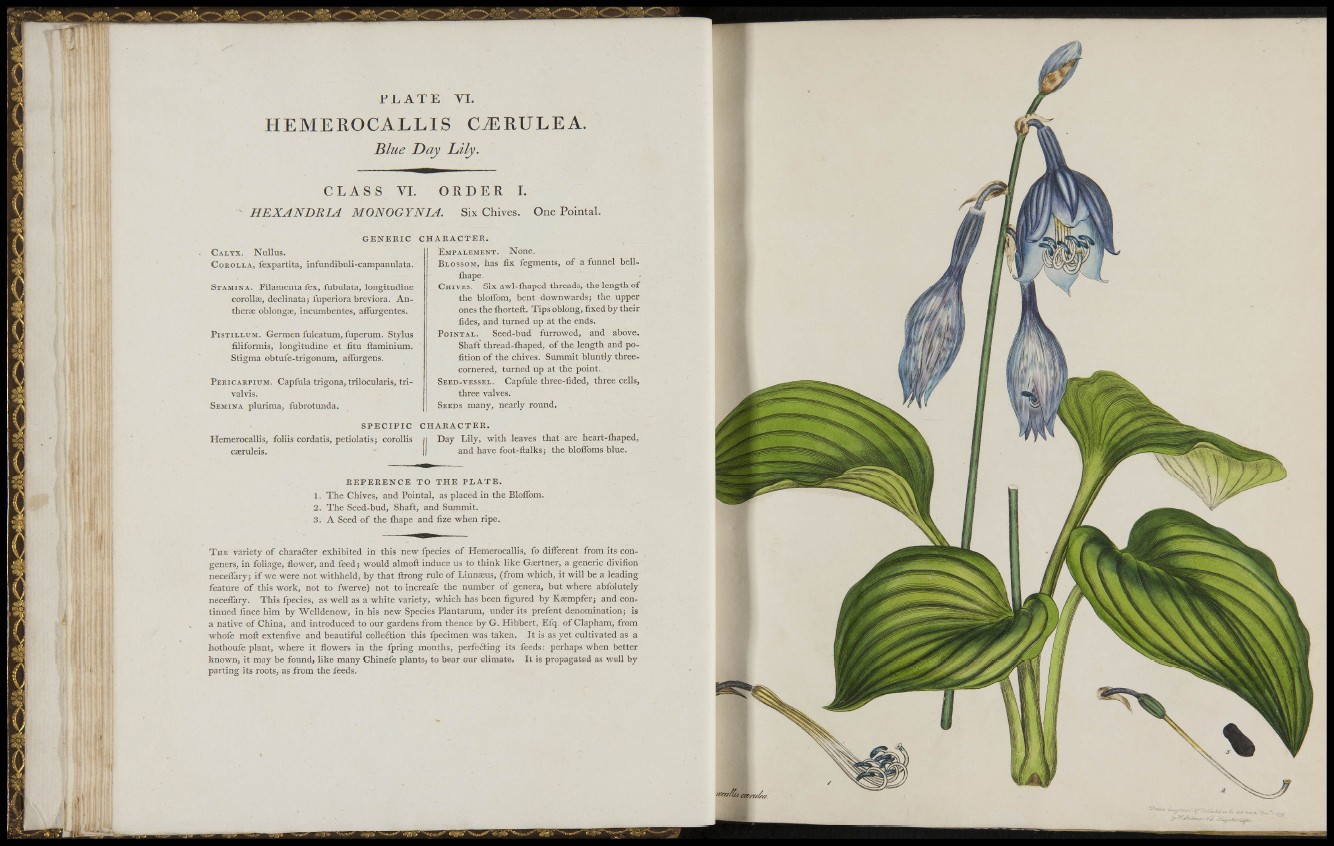
1
P L A T E VL
HEMEROCALLIS CERULEA.
Blue Day Lily.
C L A S S VL ORDER L
HEXANDRIA MONOGYNIA. Six Chives. One Pointai.
GENERIC
CALYX. Nullus.
COROLLA, lexpartita, infundibuli-campaiiulata.
STAMINA. Filameiita fex, fubiilata, longitudine
corollae, declinata; fuperiora breviora. Antherae
oblongae, incumbentes, affurgentes.
PiSTiLLUM. Germen fulcatum, fuperum. Stylus
filifomiis, longitudine et litu ftaminium.
Stigma obtufe-trigonum, affurgens.
PEKICAKPIUM. Capfula trigona, trilocukris, trivalvis.
SEMINA plurima, fubrotuiida.
S P E C I F I C
Hemerocallis, foliis cordatis, petiolatis; corollis
cseruleis.
CHARACTER.
EMPALEMENT. None.
BLOSSOM, has fix fegments, of a funnel belliliape
CHIVES. Six awl-fliaped threads, the length of
the blolTom, bent downwards; the upper
ones the iliorteft. Tips oblong, fixed by their
fides, and turned up at the ends.
PoiNTAL. Seed-bud furrowed, and above.
Shaft thread-ihaped, of the length and pofition
of the chives. Summit bluntly threecornered,
turned up at the point.
SEED-VESSEL. Capfule three-fided, three cells,
three valves.
SEEDS many, nearly round.
CHARACTER.
Day Lily, with leaves that are heart-ihaped,
and have foot-ftalks; the bloflToms blue.
REFERENCE TO THE PLATE.
1. The Chives, and Pointal, as placed in the BloiTom.
2. The Seed-bud, Shaft, and Summit.
3. A Seed of the fliape and fize when ripe.
THE variety of charafter exhibited in this new fpecies of Hemerocallis, fo difiFerent from its congeners,
in foliage, flower, and feed; would almoft induce us to think like Gajrtner, a generic divifion
necelTary; if we were not withheld, by that firong rule of Linnaeus, (from which, it will be a leading
feature of this work, not to fwerve) not to increafe the number of genera, but where abiblutely
necelTary. This fpecies, as well as a whi t e variety, which has been figured by Ka:mpfer; and continued
fince him by Welldenow, in his new Species Plantarum, under its prefent denomination; is
a native of China, and introduced to our gardens from thence by G. Hibbert, Efq of Clapham, from
whofe moft extenfive and beautiful colle6tion this fpecimen was taken. It is as yet cultivated as a
hothoufe plant, where it flowers in the fpring months, perfeiSting its feeds; perhaps when better
known, it may be found, like many Chinefe plants, to bear our climate. It is propagated as well by
parting its roots, as from the feeds.
""n/ùf ci»m/fi